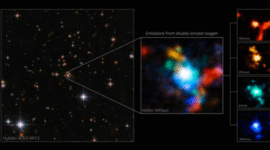July 30, 2025
In a universe teeming with colossal events, from the violent death throes of massive stars to the cataclysmic mergers of black holes, astronomers have recently unveiled a phenomenon that dwarfs all previously observed cosmic explosions. Named AT2021lwx, this unparalleled outburst of energy, first detected in 2020, has defied conventional astronomical classifications and continues to blaze across billions of light-years, emitting light equivalent to trillions of suns. Its discovery and ongoing study are reshaping our understanding of the most extreme energetic processes in the cosmos, challenging existing models of black hole activity and galactic evolution.
The initial detection of AT2021lwx was, remarkably, a serendipitous affair. Automated sky surveys, designed to scour the heavens for transient celestial events, flagged a sudden and intense brightening from a distant corner of the universe. The Zwicky Transient Facility (ZTF) in California, a wide-field survey camera attached to the Samuel Oschin Telescope at Palomar Observatory, first registered the anomaly in April 2020. This was swiftly followed by observations from the Asteroid Terrestrial-impact Last Alert System (ATLAS) in Hawaii, a network of robotic telescopes constantly monitoring the night sky. These facilities, primarily tasked with identifying rapidly changing objects like supernovae and potentially hazardous asteroids, captured the nascent stages of what would later be identified as the most energetic explosion ever witnessed.
However, the true scale of AT2021lwx remained shrouded in mystery for some time. It wasn’t until a team of international astronomers, led by researchers from the University of Southampton, delved deeper into the data that the unprecedented nature of the event became clear. Their groundbreaking research, published in the prestigious Monthly Notices of the Royal Astronomical Society on April 11, 2023, sent ripples through the astronomical community. The news broke widely around May 12, 2023, revealing an explosion that was not only incredibly bright but also remarkably long-lasting, distinguishing it from all known cosmic cataclysms.
Dr. Philip Wiseman, a Research Fellow at the University of Southampton and the lead researcher behind the study, encapsulated the initial surprise and intrigue surrounding the discovery. “We came upon this by chance, as it was flagged by our search algorithm when we were searching for a type of supernova,” Dr. Wiseman stated. “Most supernovae and tidal disruption events only last for a couple of months before fading away. For something to be bright for two plus years was immediately very unusual.” This prolonged luminosity was the first major clue that astronomers were dealing with something entirely new and extraordinary. The event has continued to radiate immense energy for over three years now, a characteristic that sets it apart from even the most powerful short-duration bursts.
To ascertain the true magnitude of AT2021lwx, the team employed a multi-pronged observational approach. After the initial detections by ZTF and ATLAS, follow-up observations were conducted using a suite of more powerful telescopes, including the Neil Gehrels Swift Observatory (a collaboration involving NASA, the UK, and Italy), the New Technology Telescope in Chile, and the Gran Telescopio Canarias in La Palma, Spain. By analyzing the spectrum of light emitted from AT2021lwx – splitting it into different wavelengths and measuring its absorption and emission features – the astronomers were able to precisely determine its distance from Earth.
Professor Sebastian Hönig, a co-author from the University of Southampton, explained the critical step in understanding the explosion’s power. “Once you know the distance to the object and how bright it appears to us, you can calculate the brightness of the object at its source,” Professor Hönig elaborated. “Once we’d performed those calculations, we realised this is extremely bright.” The calculations were staggering: AT2021lwx was determined to be approximately 8 billion light-years away, meaning the explosion occurred when the universe was only about 6 billion years old. At its peak, it shone with a luminosity roughly 2 trillion times that of our Sun, a truly mind-boggling figure. This makes it ten times brighter than any known supernova and three times brighter than the brightest tidal disruption event ever recorded. The sheer physical size of the explosion is estimated to be about 100 times larger than our entire Solar System.
The immense and prolonged energy output of AT2021lwx immediately ruled out many common cosmic explosion scenarios. Supernovae, the spectacular explosions marking the death of massive stars, are incredibly bright but typically fade within a few months. Tidal disruption events (TDEs), which occur when a star gets too close to a supermassive black hole and is torn apart by its immense gravity, also produce brilliant flares, but their luminosity is generally not as sustained or as intense as AT2021lwx.
One of the few celestial objects that can rival AT2021lwx in brightness are quasars. Quasars are incredibly luminous active galactic nuclei, powered by supermassive black holes at the centers of galaxies, which continuously accrete vast amounts of gas and dust. However, as Professor Mark Sullivan, another co-author from the University of Southampton, pointed out, AT2021lwx does not behave like a typical quasar. “With a quasar, we see the brightness flickering up and down over time,” Professor Sullivan noted. “But looking back over a decade there was no detection of AT2021lwx, then suddenly it appears with the brightness of the brightest things in the universe, which is unprecedented.” The sudden onset of AT2021lwx’s activity, without any prior detectable emission, distinguishes it from the more continuous, albeit variable, output of a quasar.
The leading theory to explain AT2021lwx’s extraordinary nature centers on a supermassive black hole violently disrupting an enormous, previously undisturbed, cloud of gas. Imagine a gas cloud, potentially thousands of times more massive than our Sun, straying too close to the gravitational maw of a dormant supermassive black hole. As fragments of this colossal cloud are pulled in, they are not immediately swallowed whole. Instead, they are thought to create immense shockwaves that propagate through the remaining gas and into a vast, dusty, doughnut-shaped structure surrounding the black hole. This powerful interaction generates the immense and sustained light that we observe as AT2021lwx.
Dr. Matt Nicholl, an Associate Professor at Queen’s University Belfast and a co-author, elaborated on why this black hole scenario is considered the most plausible. “At first, we thought this flare-up could be the result of a black hole consuming a passing star,” Dr. Nicholl explained. “But our models showed that the black hole would have to have swallowed up 15 times the mass of our Sun to stay this bright for this long. Encountering such a huge star is very rare, so we think a much larger cloud of gas is more likely.” The sheer longevity and consistent brilliance necessitate an ongoing fuel supply far exceeding what a single star could provide.
The significance of AT2021lwx extends beyond its record-breaking luminosity. It offers an unprecedented opportunity to study the extreme physics of supermassive black holes and their interactions with their environments. Supermassive black holes lie at the heart of most galaxies, including our own Milky Way, and play a crucial role in galactic evolution. Understanding how they accrete matter and release energy on such scales could shed light on the growth of black holes in the early universe and how they influenced the formation and development of galaxies over cosmic time.
One intriguing puzzle remains for the scientists: the apparent absence of a host galaxy in the vicinity of AT2021lwx. Given the presence of a supermassive black hole capable of generating such a monumental explosion, one would expect to see a massive galaxy surrounding it, perhaps even comparable in size to the Milky Way. Yet, current observations have not definitively identified such a galactic host. This “absolute puzzle,” as Dr. Wiseman called it, suggests that astronomers might be missing a piece of the cosmic puzzle or that AT2021lwx represents a truly unique and perhaps isolated event.
The research team is actively pursuing further observations of AT2021lwx across multiple wavelengths, including X-rays. These X-ray observations are crucial for revealing more about the object’s surface temperature and the intricate physical processes occurring within the heart of the explosion. Additionally, upgraded computational simulations are being conducted to rigorously test the proposed theory of a vast gas cloud being consumed by a supermassive black hole, ensuring that the models align with the observed data.
The discovery of AT2021lwx underscores the dynamic and unpredictable nature of the universe. It serves as a potent reminder that despite decades of astronomical exploration, the cosmos continues to hold profound surprises. The emergence of such an extreme and long-lasting transient event points towards the possibility of entirely new classes of cosmic phenomena that were previously unknown or theorized.
Looking to the future, the field of transient astronomy is poised for a revolution. New and upgraded observatories, such as the Vera C. Rubin Observatory’s Legacy Survey of Space and Time (LSST), are expected to come online in the coming years. These next-generation facilities will have unprecedented capabilities for surveying the sky, detecting transient objects, and generating enormous datasets. It is highly anticipated that such observatories will discover more events akin to AT2021lwx, allowing astronomers to build a statistical sample of these extreme explosions, refine their theories, and ultimately unravel the profound mysteries of black hole growth and the most energetic processes shaping our universe. The ongoing saga of AT2021lwx is a testament to the endless wonders that await discovery in the vast expanse of space.




